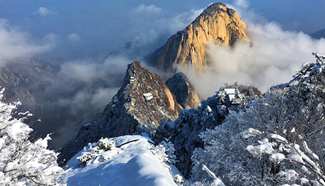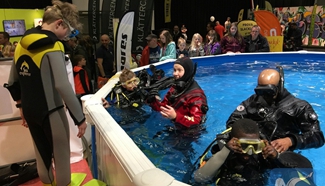SAN FRANCISCO, March 14 (Xinhua) -- Researchers have transformed pulses of electrical current sent 305 meters underground into a picture of where seawater has infiltrated freshwater aquifers along the Monterey Bay coastline in Central California on the U.S. West Coast.
The geophysical imaging technique, known as electrical resistivity tomography (ERT), measures a property called electrical resistivity. Seawater is electrically conductive due to its high salt content, while freshwater is electrically resistive. The purpose of the study was to address the phenomenon called saltwater intrusion.
"In the same way that medical imaging has revolutionized the approach to managing human health, I believe that Earth imaging using geophysical methods can revolutionize the approach to managing the health of our groundwater systems," said Rosemary Knight, who is the George L. Harrington Professor at Stanford University and specializes in adapting geophysical imaging tools to monitor and manage freshwater resources.
ERT could provide a cheaper and better alternative than the current method used to monitor saltwater intrusion, which involves drilling "sentinel" wells at specific locations. Four of the sentinel wells used to monitor saltwater intrusion along Monterey Bay cost nearly 1 million U.S. dollars to drill.
In contrast, the Stanford team's survey cost approximately 200,000 dollars. In addition, Knight explained, "unlike wells, which only give you information at one location, ERT gives you a full two-dimensional slice with spatial coverage that is just not possible with wells."
ERT surveys could also be repeated at the same spot to observe changes over time, said Adam Pidlisecky, who conducted the research while at the University of Calgary in Canada and co-author of a paper in the Journal of Hydrology. "Looking at differences through time can often be more helpful than trying to understand a single image."
To determine the extent of saltwater intrusion in the Monterey Bay region, the research team used ERT to map the salinity of groundwater along a 45-kilometer stretch of coastline from Aptos to Monterey. The survey covered nearly the entire Monterey Bay coastline one mile at a time.
The study, which is the longest and deepest of its kind, began in the fall of 2014 with researchers from Stanford University and the University of Calgary working with engineers from the engineering company WorleyParsons to lay out a long string of electrical cables along the beach. The cables were punctuated by 1.2-meter steel electrodes sunk into the sand. After a series of electrodes were in place, the team pumped tiny pulses of electricity through the connecting wire.
The current spread below the ground, and by measuring the voltage between pairs of electrodes, the team was able to create a resistivity map of the subsurface. Less resistance meant more saltwater lay below. Once the team surveyed a section of coastline, they pulled out the stakes and repeated the process elsewhere.
The data collected yielded a colorful, two-dimensional resistivity map of the coastline that reveals complex patterns of saltwater intrusion in the region down to a depth of 305 meters, and highlights the interplay between the geology and human activities controlling the region's distribution of fresh- and saltwater.
"The hope is that local water managers can use these findings to better identify regions most impacted by saltwater intrusion where targeted management practices can be most effectively implemented," study co-author Meredith Goebel, a PhD candidate at Stanford's School of Earth, Energy and Environmental Sciences, was quoted as saying in a news release.












